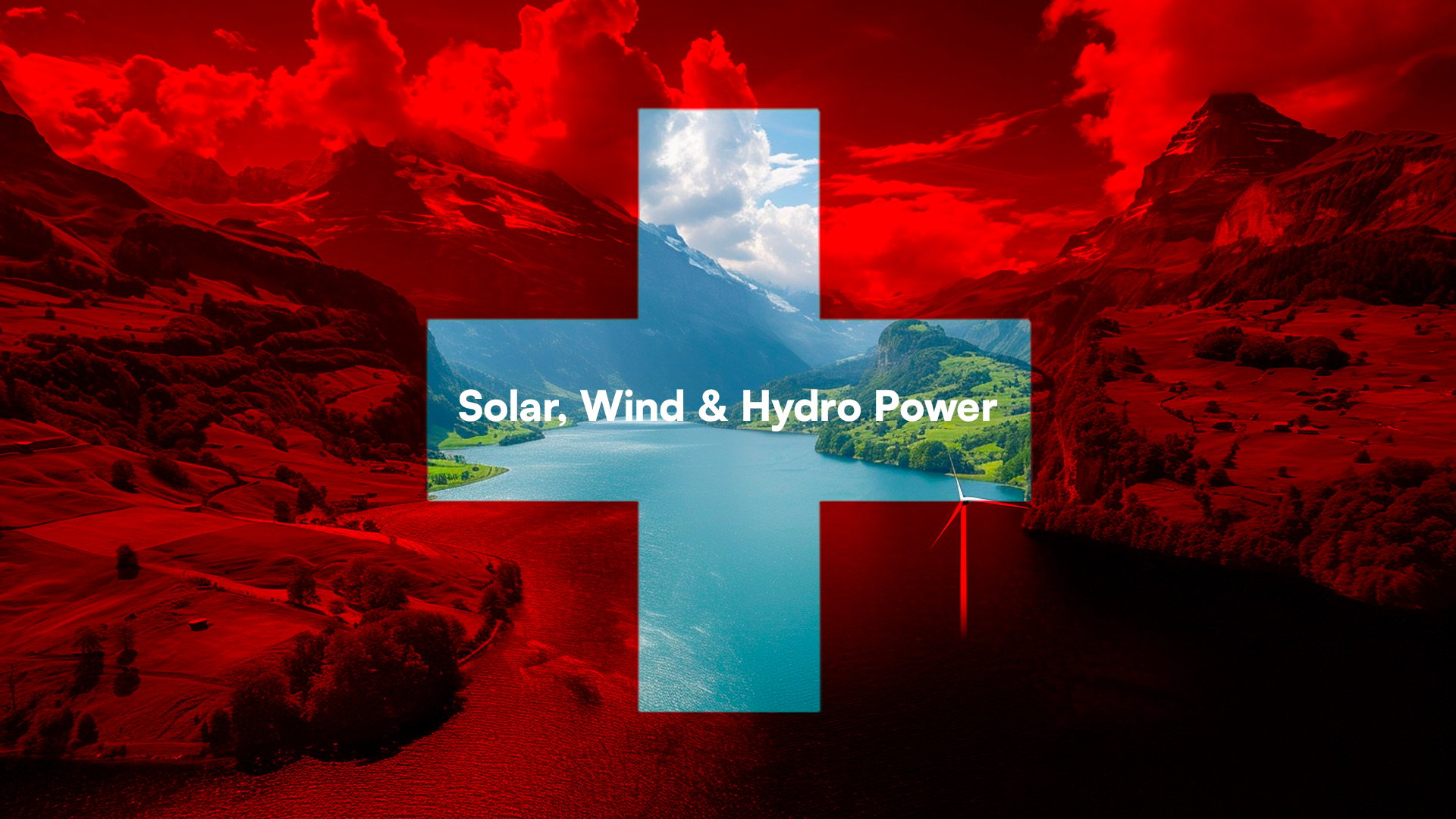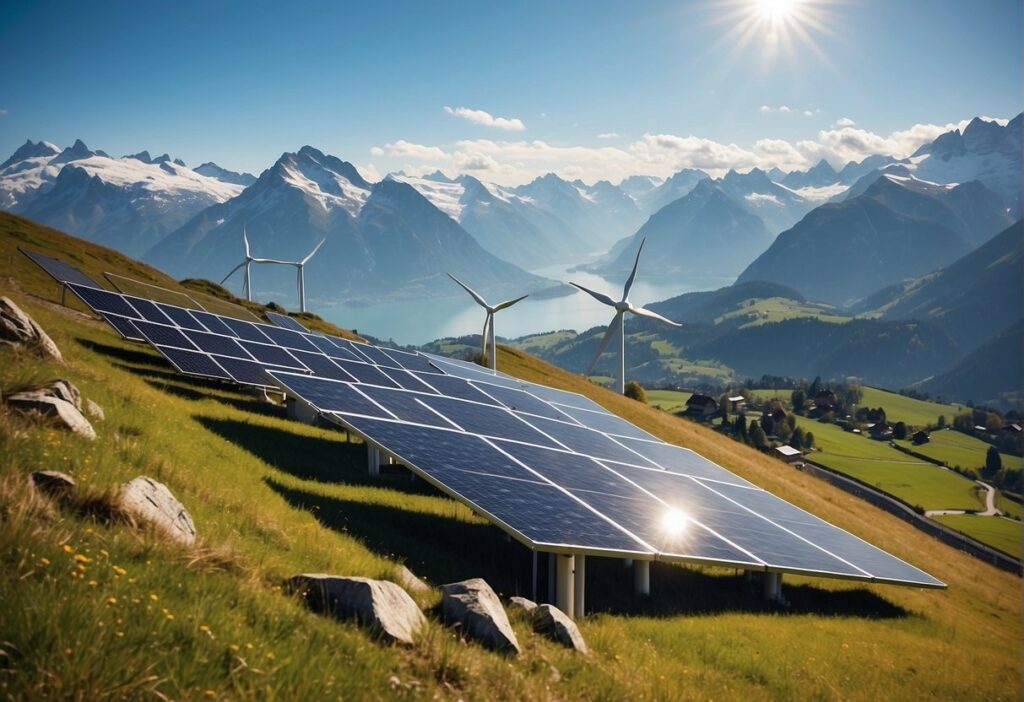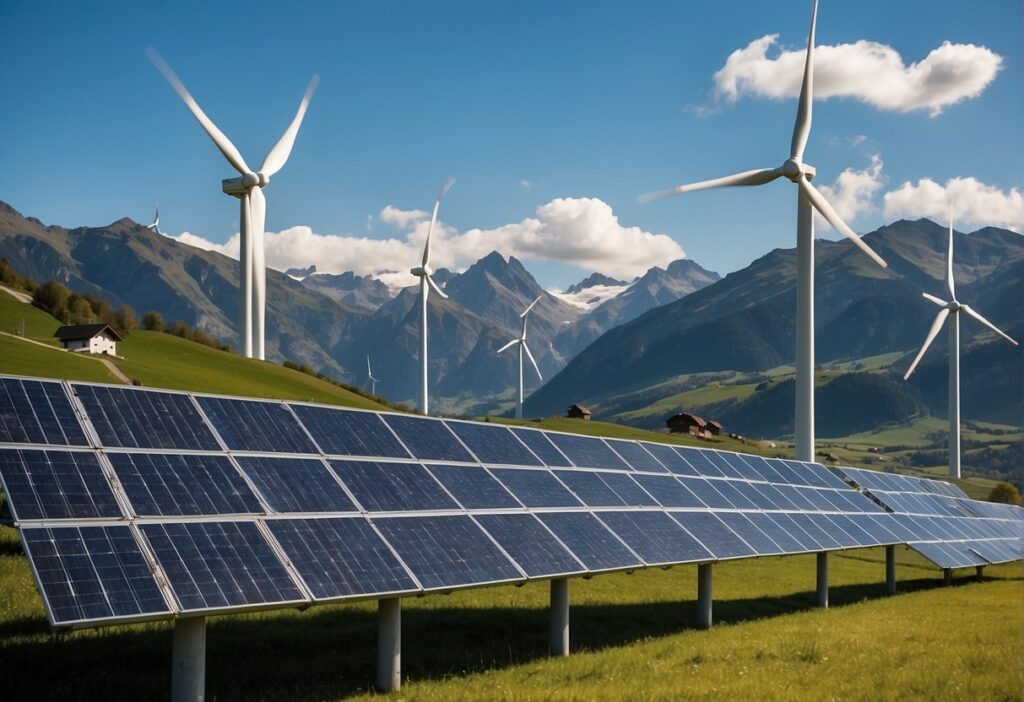How Switzerland Leads the Charge for 100% Renewable Energy

If I were to ask you which countries are leading the way in the renewable energy shift, Switzerland might not spring instantly to mind.
But the truth is that it is a notable example of a country actively working towards a sustainable future. The Alpine nation has a determined strategy to boost its renewable energy output as quickly as possible. It aims to cut its carbon footprint and greenhouse gas emissions drastically to make a real difference.
The energy transition in Switzerland follows a clear road map. The Federal Office of Energy has ambitious goals set for 2030 and beyond. They intend to increase their renewable energy to half of their energy consumption by 2030. By 2050, the goal is to reach a remarkable 75% share of the mix.
The nation has been leaning heavily on hydro power, their energy stalwart, for years. But they are also encouraging the development and use of solar and wind power. This shift aligns with the Paris Agreement and marks the country’s proactive approach to the energy policy. The entire energy sector is experiencing a transformation. The aim is to ensure a greener and more sustainable energy supply for the future.
Nuclear Power in Switzerland
Switzerland has three nuclear power plants with four reactors in total, including the Beznau plant, which has two reactors generating 365 Megawatts of electrical power each, and providing district heating.
The Gösgen plant also supplies district heating. However, Switzerland aims to rely less on nuclear energy and more on renewables by 2050.
History and Role of Nuclear Power
Switzerland embraced nuclear energy in the 1960s. They saw it as a way to meet their growing power demands. The Swiss have built a robust nuclear infrastructure. Now, four reactors are humming across three power plants. These give them about 35% of their electricity.
The drive for nuclear power was clear. Switzerland wanted less reliance on foreign oil and gas. This energy choice helped them maintain a low-carbon energy system. It suited their eco-friendly goals well. Swiss nuclear plants have a high safety record, with no major accidents or incidents.
Beznau is their oldest nuclear reactor, which came online in 1969. Two other reactors, Beznau 2 and Gösgen, also provide crucial district heating. This is on top of their main job: electricity. One can see how the Swiss nuclear energy sector supports their daily lives and industries.
The International Energy Agency praises Switzerland for its low-carbon intensity. This success comes from nuclear and hydro generation.
Phasing Out Nuclear Power
Switzerland aims to phase out nuclear power by 2050. The decision came in a 2017 referendum triggered by concerns after the Fukushima disaster back in 2011. This event sparked fear about the safety of nuclear plants. Switzerland’s people worry about possible harm to the environment.
Transitioning away from nuclear energy isn’t simple. Switzerland must overcome several challenges:
- Finding alternatives: Switzerland needs to replace the power that nuclear plants provide.
- Grid stability: There must be a constant, reliable flow of energy.
- Decommissioning: Old plants need careful taking apart once they close.
- Waste management: They must deal with radioactive material safely.
Closing a plant costs a lot. The country will spend about 20 billion Swiss francs. This includes:
- Taking apart the plants
- Handling the waste
- Paying the plant operators
Switzerland’s first plant will shut down in 2024. The last one will close ten years later, in 2034.
Solar Power in Switzerland
Switzerland’s journey towards renewable energy involves a big investment in solar photovoltaics (PV). Solar PV is essential for the nation’s energy transition.
Photovoltaic Systems
Collect sunshine and convert it to electricity. Switzerland sees solar PV as key to reducing emissions.
Contribution to the Grid
Solar power contributed just under 6% to electricity production in 2021. That’s a significant jump from earlier years.
Population and Solar Power
Switzerland’s population has embraced solar power. Investments in home solar systems show a commitment to electrification.
Challenges and Solutions
The Swiss energy transition faces technical challenges, including the need for storage solutions. Innovative technologies include electricity storage in batteries and alternative approaches like hydrogen or synthetic hydrocarbons. Each technology has its pros and cons. They need to balance efficiency, cost, and environmental impact.
Potential of Solar Power

Switzerland shines bright when it comes to solar. The Alpine regions are great spots for solar panels because the sun hits harder there. Bright sunlight and snowy reflective landscapes team up to make more energy.
The country’s solar energy scene is bustling, too. It’s growing fast, very fast indeed, with a growth rate of about 30% per year. People in Switzerland are seeing more and more solar panels popping up everywhere.
Statistics Speak Volumes:
- Installed solar capacity? A strong 4.6 gigawatts at the end of 2022.
- That’s providing about 7% of Switzerland’s electricity.
And the future looks even sunnier. Plans are in place to really amp up solar power. By 2035, the Swiss are aiming for 25 TWh/year. Big numbers? Absolutely. Big impact? Definitely.
They want solar energy to light up one-fifth of the country by 2035. And by 2050? Half of the electricity could be solar. That’s half of Switzerland running on pure sunshine.
Benefits and Challenges of Solar Power

Benefits of Solar:
- It cuts carbon. It could slash about 1.5 million tons of CO2 annually.
- It creates jobs. Tens of thousands of jobs will be created by 2050.
- It reduces reliance on outside energy. Particularly in winter, when Switzerland buys three-quarters of what it uses.
- It drives invention. Efforts in technology for solar power are really taking off.
Challenges:
- Sunlight varies. The sun’s rays can change by 80% due to season and weather.
- Land is precious. Around 10 square meters of space is needed for each kilowatt of power.
- Materials matter. For every kilowatt, you need about 16 kilograms of stuff to build panels.
Solar Power Projects
Switzerland’s journey toward renewable energy showcases a number of impressive solar projects. Here are some examples.
The Solar Dam on Lake Muttsee stands tall as Europe’s highest solar power plant. It soars at 2,500 meters. This marvel sports 5,000 solar panels. They churn out 3.3 million kilowatt hours yearly. That’s ample power for 700 homes. In winter, it benefits from snow-reflected sunlight.
The AlpinSolar project is behind this feat. They partner with Swiss powerhouses Axpo, IWB, and Denner to harness the power of alpine sun.
This solar dam does more than just gather sunlight. It combines with hydro power to help move water between reservoirs. This boosts the dam’s power efficiency.
They call it innovation amidst the peaks. Cameras and sensors guard the panels. These monitors brave the extremes, ensuring resilience. The project epitomizes how to harness solar energy in remote, tough spots.
Here’s a quick look at the solar dam’s impressive stats:
- Location: Lake Muttsee, Switzerland
- Altitude: 2,500 meters
- Production: 3.3 million kWh/year
- Homes Powered: 700
- Unique Feature: High winter production
Wind Power in Switzerland
Wind power plays a key role in Switzerland’s energy strategy.
In 2022, Swiss wind turbines produced more electricity than ever. They generated 153 gigawatt hours of electricity, a 5% increase from the previous year.
Policy plays a part in reaching the 2030 climate targets. Cutting red tape can speed up the deployment of wind projects. Good policy measures can make this easier. Switzerland needs this for a faster transition, in line with the suggestions of the International Energy Agency.
Potential of Wind Power
Switzerland harnesses the wind. The country has 75 megawatts of installed wind capacity, which meets just 0.2% of its electricity needs. However, the future looks bright.
The goals are clear. By 2050, they aim for 4,400 megawatts of energy from wind. That’s enough to supply about 10% of Switzerland’s electricity.
The Jura mountains and the high Alps are key. They have strong, consistent winds. These areas are perfect for wind turbines.
Benefits and Challenges of Wind Power
Benefits of Wind Power:
- Wind farms decrease CO2 by about 1 million tons yearly in Switzerland.
- By 2050, wind energy could create roughly 10,000 jobs.
- During winter, Switzerland buys much of its electricity. Wind power can cut this dependence.
Challenges of Wind Power:
- The wind is unpredictable. It can change by 90% due to fluctuating weather conditions.
- Wind turbines need space. About 0.5 square meters per kilowatt of capacity.
- The look of the land can change.
- Wind turbines can be noisy. They can reach 50 decibels.
Wind Power Projects
Switzerland is making big strides in wind power. Projects like the wind farm in Mont Crosin show this progress. This farm is the biggest and oldest in Switzerland. It has 16 wind turbines.
These turbines make 38 gigawatt-hours annually, powering up to 10,000 homes.
The Mont Crosin wind farm is a team effort. Locals, the canton, and the government all work together. This cooperation plays a key part in the farm’s success.
The turbines are unique. They match the Jura mountains where they stand. The climate and wildlife there are special, and the turbines are designed to suit this beautiful area.
This wind farm shows that wind power works with other energy types. Pairing it with solar and hydropower makes a strong energy mix.
Mont Crosin is more than just a wind farm. It’s a symbol of how people and nature can work together. It’s proof that with smart planning, wind power can meet challenges. They adapt and thrive even in tough places. And this is how Switzerland meets its energy goals

Hydro Power in Switzerland
Switzerland invests heavily in hydropower, relying on it for most of its electricity production. The country’s hydroelectric power plants harness water’s energy and are essential for energy security.
Storage facilities play a vital role in ensuring a steady energy supply. This way, they help meet peak demand. These storage facilities also help balance the grid.
Switzerland sees hydropower as more than just energy. It’s a way to achieve sustainability. Investment in hydro is high, balancing growth with nature.
The country is making progress towards the future. Innovations, such as the combination of hydro and solar power, are emerging. The solar dam highlights this trend, meeting the needs of hundreds of homes each year.
They focus on maintaining the ecological balance. Hydroelectric systems impact rivers and wildlife, but the Swiss approach minimizes this. They tread carefully, respecting their environment.
Potential of Hydro Power
Switzerland counts on hydropower for about 60% of its electricity.
It has a large system to make this work. About 1,400 hydropower plants are the heart of this system. Together, these plants have a capacity of 16.4 gigawatts. Each year, they produce around 36 terawatt hours of electricity.
And it isn’t stopping there. It wants to grow its hydropower use even more. By 2050, Its goal is to increase hydropower production by 10%. They will improve existing plants and build new ones to achieve their goal.
- Hydro power plants in Switzerland: 1,400
- Total capacity: 16.4 gigawatts
- Annual electricity production: 36 terawatt hours
- 2025 target: Increase by 10%
Switzerland knows how important clean energy is. So, they work hard to protect their environment, making sure rivers and wildlife stay healthy. This balance isn’t easy, but it’s important for their future.
As they work on this, the world watches. Switzerland’s choices may lead the way for other countries as they show how to take care of nature while making energy. This is their journey now and for years to come.
Benefits and Challenges of Hydro Power
As Switzerland continues to pursue its goal of increasing hydropower production, it is important to acknowledge the benefits and challenges of this clean energy source.
Benefits of Hydro Power:
- It’s a clean energy source, drastically reducing greenhouse emissions.
- For Switzerland can cut carbon emissions – in 2022, it produced 32.9 million tonnes, according to Statista.
- This power source also boosts job creation, leading to thousands of new roles.
- It’s key for energy security, lessening the country’s reliance on outside electricity, which is crucial in winter months when imports can reach 75%.
- Hydroelectric energy drives innovation. Research in hydro turbine technology and energy efficiency flourishes.
- Swiss hydropower has been instrumental in preparing the nation for an impending energy shortage by focusing on renewable sources.
- It supports the economy, being a force behind job growth and energy stability.
Challenges of HydroPower:
- Climate change is a significant hurdle. It alters water cycles, impacting water availability.
- Hydroelectric facilities require considerable land area, about 100 square meters per kilowatt. This can affect local biodiversity and culture.
- Hydropower affects water quality and quantity. Ecosystems, fisheries, and human health feel the impact.
- The construction of dams and reservoirs has marked environmental and social effects.
- Switzerland needs innovation to store renewable energy for times of scarcity. Developing storage solutions for the energy sector remains a priority.
- Ensuring that new hydroelectric capacity keeps pace with demand is essential to meet long-term decarbonization goals, as the International Energy Agency indicates.
Hydro Power Projects
Switzerland is pushing forward with hydroelectric power. They look to projects like the Nant de Drance for inspiration.
The Nant de Drance Plant
The pumped storage plant in Nant de Drance stands out. It’s underground, a marvel in the Alps. They built it with strength, enduring rocky terrains.
- Capacity: 900 megawatts.
- Storage: 25 million cubic meters.
Smart Design
At Nant de Drance, ingenuity comes to life. It uses the height between two lakes to generate electricity. When demand peaks, the plant springs to action.
Collaboration for the Future
A joint effort made this plant possible. Alpiq, Swissgrid, and the Swiss Federal Railways teamed up. Their goal? To boost the Swiss electricity grid by 2025.
Power in Tough Spots
The Nant de Drance facility was built to withstand any challenges that may arise. Set deep in the mountains, it faces harsh conditions. Yet, it proves remote locations can harness hydropower.
Switzerland’s hydroelectric strides are impressive. It shows the world how to blend innovation with nature. Through plants like Nant de Drance, renewable energy thrives.
Projects like these lead to a brighter, greener future. They guide nations in renewable energy pursuits.
So, Switzerland is moving in the right direction. They want all their energy to be clean one day. This will help keep our planet safe for the future. They’ve taken solid steps and have clear plans. They are an example to other countries around the world.
Before You Go…
Before you finish up, take a moment to uncover “21 Fascinating Facts About Switzerland.” This article offers a captivating exploration of Switzerland’s unique attributes, going beyond its success in clean energy.
Whether you’re a traveler seeking inspiration, a student of global cultures, or simply someone with an inquisitive mind, this piece provides a compelling look into Switzerland’s distinctive charm.
Don’t miss the chance to gain fresh perspectives and insights into Switzerland’s rich history, traditions, and natural marvels. So, before you go, be sure to immerse yourself in “21 Fascinating Facts About Switzerland” and open the door to a world of discovery.